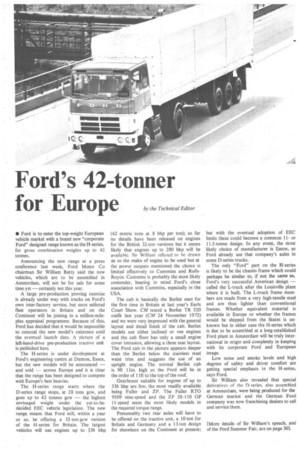Ford's 42-tonner
Page 14

If you've noticed an error in this article please click here to report it so we can fix it.
for Europe by the Technical Editor
• Ford is to enter the top-weight European vehicle market with a brand new "corporate Ford" designed range known as the H-series, for gross combination weights up to 42 tonnes.
Announcing the new range at a press conference last week, Ford Motor Co chairman Sir William Batty said the new vehicles, which are to be assembled in Amsterdam. will not be for sale for some time yet — certainly not this year.
A large pre-production proving exercise is already under way with trucks on Ford's own inter-factory service, but soon selected fleet operators in Britain and on the Continent will be joining in a million-mileplus appraisal programme. Because of this, Ford has decided that it would be impossible to conceal the new model's existence until the eventual launch date. A picture of a left-hand-drive pre-production tractive unit is published here.
The H-series is under development at Ford's engineering centre at Dunton, Essex, but the new models will be announced — and sold — across Europe and it is clear that the range has been designed to compete with Europe's best heavies.
The H-series range starts where the D-series range stops, at 28 tons gcw, and goes up to 42 tonnes gcw — the highest envisaged weight under the yet-to-bedecided EEC vehicle legislation. The new range means that Ford will, within a year or so, be offering a 32-ton-gcw version of the H-series for Britain. The largest vehicles will use engines up to 336 bhp (42 metric tons at 8 bhp per ton); so far no details have been released on engines for the British 32-ton versions but it seems likely that engines up to 280 bhp will be available. Sir William refused to he drawn as to the make of engine to be used but at the power outputs mentioned the choice is limited effectively to Cummins and RollsRoyce. Cummins is probably the most likely contender, bearing in mind Ford's close association with Cummins, especially in the USA.
The cab is basically the Berliet seen for the first time in Britain at last year's Earls Court Show. CM tested a Berliet TR 320 outfit last year (CM 24 November 1972) and we were very impressed with the general layout and detail finish of the cab. Berliet models use either inclined or vee engines and the cab floor has only a small engine cover intrusion, allowing a three seat layout. The Ford cab in the picture appears deeper than the Berliet below the stainless steel waist trim and suggests the use of an upright engine. The normal Berliet cab is 9ft 1 lin. high so the Ford will be in the order of llft to the top of the roof.
Gearboxes suitable for engines of up to 336 bhp are few, the most readily available being Fuller and ZF. The Fuller RTO 9509 nine-speed and the ZF 5S-110 GP 11-speed seem the most likely models in the required torque range.
Presumably two rear axles will have to be offered on the tractive unit, a 10-ton for Britain and Germany and a 13-ton design for elsewhere on the Continent at present; but with the eventual adoption of EEC limits these could become a common 11or 11.5-tonne design. In any event, the most likely choice of manufacturer is Eaton, as Ford already use that company's axles in some D-series trucks.
The only "Ford" part on the H-series is likely to be the chassis frame which could perhaps be similar to, if not the same as, Ford's very successful American design — called the L-truck after the Louisville plant where it is built. The L-truck frame members are made from a very high-tensile steel and are thus lighter than conventional frames. Whether equivalent material is available in Europe or whether the frames would be shipped from the States is unknown but in either case the H-series which is due to be assembled at a long-established Ford plant in Amsterdam will be truly international in origin and completely in keeping with its corporate Ford and European image.
Low noise and smoke levels and high degrees of safety and driver comfort are getting special emphasis in the H-series, says Ford.
Sir William also revealed that special derivatives of the D-series, also assembled at Amsterdam, were being produced for the German market and the German Ford company was now franchising dealers to sell and service them.
































































































